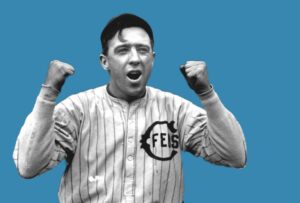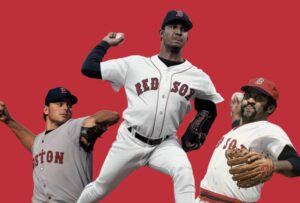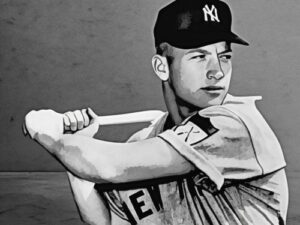Once upon a time, the Baltimore Orioles were baseball’s model franchise. From the mid-1960s to the early 1980s, the Orioles were the most successful team in the game. They won six pennants and were three times crowned World Champions. The black and orange and the cartoon bird became a fixture in the postseason.
The franchise was guided by a philosophy known as “The Oriole Way,” a set of rules and methodologies that produced winning players and teams built on defense, pitching, and the three-run homer.
As of the end of the 2019 season, the following players constitute the top twenty players in Orioles’ history according to Wins Above Replacement (WAR).
20. Rafael Palmeiro
The once proud Baltimore franchise was stained in the 1990s by a long line of players who used performance-enhancing drugs. Many of them were caught, failed tests, or admitted their usage years after the fact. Palmeiro is the poster boy for that “dirty bird” era. He played seven seasons in the city in two stints with the O’s. The team welcomed him back for the final two years of his career so he could get his 3,000th hit. After he adamantly told a congressional hearing that he had never used steroids (“not once ever”), he later failed a test and was shamed.
A few of the other Orioles who have been implicated in steroid use: Brady Anderson, Brian Roberts, Miguel Tejada, Jason Grimsley, David Segui, Jay Gibbons, and Chris Davis. Others suspected were Geronimo Berroa, Lenny Webster, Mike Bordick, Chris Hoiles, Jeffrey Hammonds, and even Melvin Mora. For a brief spell, just to make the team an “official sponsor of cheating”, Sammy Sosa was in an Orioles’ uniform.
The other team of that era that was riddled with steroid users was the Texas Rangers. There were two common denominators on those teams: Palmeiro and manager Johnny Oates, a man who must have gotten used to stepping lightly around syringes.
What to say about Palmeiro, a Faustian character we haven’t seen in the game since Hal Chase? Well, like Chase, Raffi was a popular player with wonderful baseball skills who decided to break the rules to enhance his wallet. Many observers considered Chase the greatest first baseman of the first two decades of the 20th century, a player worthy of the grandest honor, the Hall of Fame, had he not been driven from the game due to fixing games. Palmeiro is destined to be a shining example of sliminess: a wonderful player on paper, but a terrible character who would be more appropriate as a villain in a Sherlock Holmes novel.
19. Al Bumbry
Before he played a game in the big leagues, Bumbry stared death in the eyes during a stint in Vietnam in the U.S. Army. Bumbry was a tank platoon leader, responsible for 45 men and the equipment in his platoon. He won a Bronze Star for his bravery and leadership. When he returned to the States, he was 24 years old, a more mature man and a more mature player. He quickly navigated his way through the Orioles’ organization and in 1973 he was in the outfield, playing alongside Paul Blair and Don Baylor. He won the American League Rookie of the Year, batted .337 and showed off his speed.
Bumbry settled in as a useful center fielder for Earl Weaver after Blair left Baltimore, and he was an All-Star in 1980 when he had 205 hits. He was often platooned and rarely faced left-handed pitchers.
18. Dave McNally
“McNally was a tenacious guy and really stubborn,” Jim Palmer once said. “He won 20 games four times. When I was injured I would sit in the stands and watch him, and I learned how to pitch.”
In 1971, McNally, Palmer, Mike Cuellar, and Pat Dobson each won 20 games, the last time a team has had four 20-game winners on their staff. McNally actually missed five weeks that season with a sore arm, but when he went on the shelf he already had 13 victories. Upon his return in August he got back on track, and in early September he shut out the Yankees to clinch the division title and record his 20th win. Within six days, the Orioles saw all four men win their 20th game.
McNally held the Orioles’ franchise record for victories when he asked to be traded in 1975. The probable reason for his request was the multiple contract squabbles he had with the front office. He spent a failed season in Montreal, served as one of the players who challenged the reserve clause, and retired. He remains one of the most popular pitchers to ever wear the Orioles’ uniform.
“Dave was an unbelievable competitor,” remembered Earl Weaver. “He did it with cunning and intelligence. He loved to set you up with a change, fool you with that tremendous curve and then throw the fastball by you. Plus he was 100 percent gentleman. He was the kind of guy you wanted your son to be.”
17. Nick Markakis
Markakis is a quiet player, known for being pretty low-key in the clubhouse.
“Go about your business, mind your own business,” Markakis has said. “Do what you’re supposed to do, and not such much with the mouth, but by example.”
He was a center fielder out of position in right field, but it worked because he played with Adam Jones. The pair won six Gold Gloves together in the Baltimore outfield.
Entering 2020, Markakis had an outside chance of reaching 3,000 hits some day. But his declining production the prior two seasons and the abbreviated schedule in 2020 probably destroyed any chance at that.
16. Brian Roberts
I wrote somewhere else that there are three types of doubles hitters:
- Aggressive base runners who stretch their share of singles into doubles.
- Power hitters who hit the ball over outfielders or in the gaps.
- Guys who pull the ball down the lines a lot.
Roberts was mostly #3. A switch-hitter, he was a pull-hitter, yanked a lot of balls down the chalk. Only five players have hit 50 doubles three times or more, all of the others are immortals. There’s Tris Speaker (who did it five times), Paul Waner, Stan Musial, Albert Pujols, and finally Roberts. Talk about a misfit.
15. Melvin Mora
Baseball history has witnessed few players like Mora. He spent seven plus years in the minor leagues with two organizations struggling to make The Show. He was 32 years old before he got a permanent position in the lineup at the major league level. That year, he suddenly hit .340 with 27 home runs as Baltimore’s third baseman. His career carved up this way: he had two great seasons, two good seasons, and was average or below average every year besides that. His unusual spike in productivity after the age of 30 is certainly suspicious. But hey, he got paid: he made more than $40 million playing a game.
14. Ken Singleton
Forty times the player Mora was and four million times the person. Singleton was a high percentage player and a gentleman. He was one of Earl Weaver’s favorites, a switch-hitter with power and a great eye from both sides of the plate.
Prior to the 1979 World Series when the Pittsburgh staff was going over the scouting reports on Baltimore’s lineup, Bert Blyleven was asked about Singleton, whom he’d faced when he was in the American League. “He can hit it up, hit it down, hit the fast ones and the curves,” Blyleven said, “the best option is to walk his ass.”
13. Manny Machado
Has more than 200 home runs before his 27th birthday. But even if “Mr. Hustle” were to average 40 homers per season until he’s 38, he’d still be 80 homers shy of Bonds.
12. Adam Jones
Only Ripken, Robinson, and Murray have more hits in a Baltimore uniform than Jones, who ranks in the top ten in almost every offensive category for the franchise.
Sort of Chet Lemon-light, right down to the boneheaded base running. Jones could go get ’em, and he had some pop in his bat, but like Lemon, he’s aging out in his mid-30s.
11. Frank Robinson
Was said to be an “old thirty” when the Reds traded him to Baltimore. Robinson won the triple crown his first season with the O’s, becoming the first player to win the MVP in both leagues. Without Robby, there’s no “Oriole Way”, no dynasty, no extended string of success in Baltimore. He was the anchor in the lineup, the leader in the clubhouse, the judge in the kangaroo court.
A lot of people forget how great Robinson was. Think of Hank Aaron and remove about 5 percent, that was Frank Robinson.
10. Brady Anderson
If Frank Robinson signified the beginning of the Oriole dynasty, Brady Anderson and his sideburns signaled the end. Probably added five years to his career through pharmaceuticals. Otherwise, he was Chris Singleton.
9. Boog Powell
Powell ended his career in 1977 with a few months playing for the Dodgers. The Dodger Stadium concession stands had a menu item called “Helmet Nachos” that was quite literally, a Dodgers’ batting helmet filled with greasy nachos. According to legend, during one game that summer when he wasn’t in the lineup, Powell had a bat boy order him Helmet Nachos and proceeded to scarf them down in the clubhouse. Manager Tommy Lasorda summoned Boog to pinch hit mid-nacho, and the big slugger put the cheese-filled helmet on his head and went into the game.
8. Bobby Grich
The best defensive infields in the history of baseball were the Baltimore group from 1972 to 1975, that had Grich at second base, Mark Belanger at shortstop, and Brooks Robinson at third base. Grich, Robinson, and Belanger won 15 of the 16 Gold Glove Awards available in those four seasons. Boog Powell, who started in three of those years, was no slouch, and Lee May was very good around the bag too.
In those four seasons the Orioles allowed 114 fewer unearned runs than any other team in the American League. They led their league in pitching each season, naturally. With that airtight infield and Paul Blair and Al Bumbry in the outfield, Baltimore didn’t make many mistakes in the field.
Grich’s strength was his anticipation and sure hands. Three times he handled as many as 900 chances, a feat only matched by Bill Mazeroski. He ranks among the ten greatest defensive second basemen in history, even if Cooperstown has snubbed him.
“I didn’t have Brooks Robinson’s hands, Mark Belanger’s range or Joe Morgan’s quickness,” Grich said, “but I got to more balls than other guys who were 6 feet 2 and 200 pounds because, on every pitch, I got a jump. I cheated so much, I caught balls on the outfield grass and threw guys out.”
7. Paul Blair
One man’s selection of the best center fielders of all-time:
- Tris Speaker
- Willie Mays
- Andruw Jones
- Paul Blair
- Richie Ashburn
- Chet Lemon
- Gary Pettis
- Willie Davis
- Garry Maddox
- Scoops Carey
Some players are fast, some are quick (there’s a difference). Some outfielders have a great first step, and some have excellent instincts. Blair had all of that, and his arm was good too. A prototypical center fielder, and he played shallow.
6. Mark Belanger
Everyone knows Mark Belanger was a phenomenal shortstop, he’s one of the ten best to ever play the position. Most people also know he was a pretty dreadful hitter. It wouldn’t surprise you, I suppose, that Belanger was 4-for-48 (.083) against Gaylord Perry, or that he was 2-for-22 off Rollie Fingers. But you’d probably be shocked to know that Belanger hit .421 (8-for-19 with three doubles) off Goose Gossage. Sometimes, those things don’t make sense.
Belanger was a winner. His American Legion team (Pittsfield, Massachusetts) finished third in the country his senior year. In the minor leagues his teams won three titles in four years. In his 16 full seasons with Baltimore, the team won 90+ games 13 times. In his professional career his teams finished in first place ten times.
5. Mike Mussina
Who was the greatest Orioles’ pitcher of all-time? Jim Palmer rates higher in career WAR because he spent his entire career in Baltimore, while Moose only pitched ten years for the team. But one way to answer the question is by looking at their peak performance according to Wins Above Replacement:
| Best 3 | Best 5 | Best 7 | |
| Mike Mussina | 20.0 | 30.9 | 40.3 |
| Jim Palmer | 22.5 | 35.3 | 46.9 |
Clearly Palmer was more valuable, though both were excellent. Mussina deserves to be in the Hall of Fame, and he’ll get there eventually (*He did in 2019). Palmer had a larger impact because he was a tad better and he pitched about 25 more innings per season. Both pitchers are among the 100 greatest pitchers in baseball history.
4. Eddie Murray
It became commonplace to describe Eddie Murray as aloof, distant, grouchy. He didn’t talk to the media much, so he was almost always called “quiet” too. But Eddie Murray is a fun guy, he has a great personality. He likes to laugh, he enjoys it. Eddie didn’t trust people, and early in his professional baseball career a few reporters screwed him over, so he was very careful after that. He gave most of the media his “bad ass face.” But it was a protective device. Among his friends, those people he trusted, Murray was gregarious and known for his loud, booming laugh.
3. Jim Palmer
See the Mussina comment.
2. Brooks Robinson
Robinson was a second baseman when he signed with Baltimore, spurning offers from several teams. He chose the Orioles because the franchise was so bad, he figured it would be much easier to get to the big leagues. He was right, but as a young prospect, Robinson did not impress everyone.
“He couldn’t hit, he couldn’t run, and his arm wasn’t that strong,” teammate Gen Woodling said when he saw the 19-year old Robinson in spring training.
True, Robinson was far from flashy as an athlete, but he was efficient, fundamentally sound, and nearly perfect as a defender. The Orioles groomed him to replace veteran George Kell at third, and once Robinson got the job he held it for two decades.
There are four players whose defensive statistics stand out as freakishly good: Ozzie Smith, Bill Mazeroski, Tris Speaker, and Brooks Robinson.
1. Cal Ripken Jr.
The greatest shortstop of all-time was the last man to bat at Memorial Stadium and the man who “built” Camden Yards. Ripken was on deck on October 6, 2001, in Baltimore awaiting his last at-bat, but teammate Brady Anderson, also playing his last game for the O’s, struck out to end the game.






